allTURNatives: Form + Spirit 2018
August 3 – October 20 2018
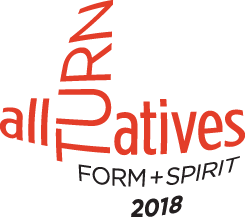
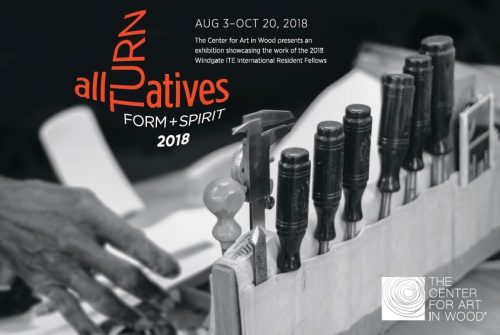
Photo by Cristina Tamarez
Now in its twenty-third year, the Center’s Windgate ITE International Residency program is a collegial experience that encourages an open exchange of creative and technical innovations in the field of art in wood. Throughout the summer, the resident fellows live at the University of the Arts and use studio space there and at NextFab where they can pursue both individual and collaborative work. The program culminates in the current exhibition, allTURNatives: Form + Spirit 2018. The 2018 residency experience was documented via their blog at https://internationalturningexchange.wordpress.com/ To learn more about the program, visit our Windgate ITE page.
The 2018 Windgate ITE Resident Fellows are: Cha Jong-Rye, Artist (Gyeonggi do, Korea); Vivian Chiu, Artist (NY, USA); Morgan Hill, Artist, (NC, USA); Jack Mauch, Artist (MA, USA); Michael Puryear, Artist (NY, USA); Janine Wang, Student artist (NY, USA); Cristina Tamarez, Photojournalist (NY, USA); Seán Breen, Scholar (Connacht, Ireland)
Opening reception with the Windgate ITE Resident Fellows | Aug 3 | 5:30-8 PM Gallery talk | 6-7 PM
Special thanks to our partners: John Haggerty, Wood Processes Manager at NextFab, and the University of the Arts: Administrative Coordinator Regina Barthmaier, Housing Coordinator Amy Beal, Wood Shop Supervisor Tara Inman-Bellofatto, Media Resources Photography Coordinator Jeffery Einhorn, and Craft & Material Studies Associate Professor, Don Miller. Thanks also go to Fairmount Park Wood Recycling Center for materials. We are grateful to Phil Brown & Barbara Wolanin, co-organizers of the Maryland trip, and our hosts Mary Beardsley, Dr. Jeffrey Bernstein & Dr. Judy Chernoff, Fleur Bresler, David Fry, Marc, Diane, & Jason Grainer, Ed Grossman & Shelley Stanfield, Jerry & Deena Kaplan, and Darrell & Debra Tanno. For local trip coordination and tours we thank Mira Nakashima at
Nakashima Woodworker, Mark Sfirri, and Wharton Esherick Museum.
This year’s Windgate ITE Program & Exhibition is generously supported by the Cambium Giving Society members of The Center for Art in Wood, donors to the Windgate ITE appeal, the Bresler Family Foundation, National Endowment for the Arts, Pennsylvania Council on the Arts, Philadelphia Cultural Fund, William Penn Foundation, and Windgate Charitable Foundation. In-kind support was provided by Boomerang, Inc, Signarama Center City, Sun-Lite Corporation, and Winterthur Museum, Winterthur, Delaware.
NOTE: Any work dated with ITE denotes work that was produced during this year’s residency. Any works not denoted as NFS (Not For Sale) or SOLD are available for sale: for PDF of the price list, click here. If you have an inquiry about any items for sale please contact Lori Reece, Director of Administration and Museum Store Sales, at 215-923-8000 or by email at [email protected].
- Seán Breen, Scholar-in-Residence Reflects on ITE 2018
- Video: The 2018 Windgae ITE International Residency Program
I arrived mid-point to the programme as an Educator in Furniture Making at The Galway Mayo Institute of Technology at Letterfrack – The National Centre of Excellence in Furniture Design and Technology and Co-founder of Benchspace Cork, a creative hub providing affordable access to machinery and space for start-up designer makers, primarily in the medium of wood. Most of all I was interested to observe which elements of the programme best encouraged the exchange of knowledge and experiences and to then bring this knowledge back to Ireland for the benefit of students and staff at GMIT Letterfrack, supported makers in Benchspace and as a bedrock of knowledge for an Artist in Residence Programme I have helped to initiate that commences in September 2018—Ireland’s first dedicated woodworking residency.
The transfer of valuable knowledge, or residency cross-pollination as I have termed it, encompasses the exchange of practical information beneficial to a creative’s resolution in making, resulting in shared experiences that have an immediate effect on tangible outputs and processes, as well as the long term positive affirmations of the experience, which may not become apparent in the artists’ work for many years.
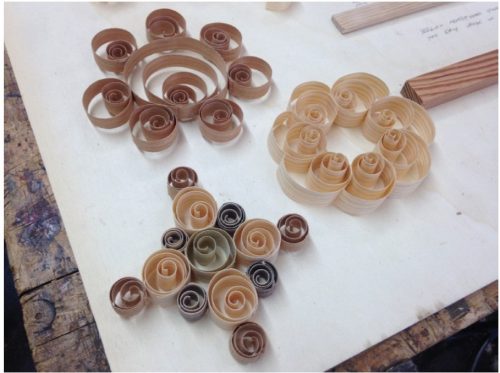
At the Bench: Timber Shaving Exploration. Photo: Seán Breen
My methodology consisted of a largely ethnographic in nature observation. I took a workbench alongside the other residents and explored a Scandinavian shaving ornament technique, which has been sparsely documented in the English language, using my own hand tools. This gave me an artist’s perspective as I was situated for the week right in the heart of the workshop. Semi-structured interviews provided further information while just as significant, the rich discourse through interactions inside and outside of the workshop rounded out the study.
Upon arrival one of the most impactful aspects of the programme that, I believe, led to increased residency cross-pollination became apparent. The complete freedom of expression and licence to create afforded to the residents, yet all the while with the utmost of support provided when needed by the Center. I visited both the well-equipped University of the Arts workshops and the Center at its gallery opening, not more than a few hours after landing from a transatlantic flight. Their staff welcomed me with a confidence and warmth that was reassuring. By the presence of such a resolved organisation as the Center steering the program, an air of confidence permeated the residents’ approaches to work. From early morning to late in the night, residents would overlap in their interactions with one another unconstrained in their creative flow, yet all the while fully supported by effortless curation.
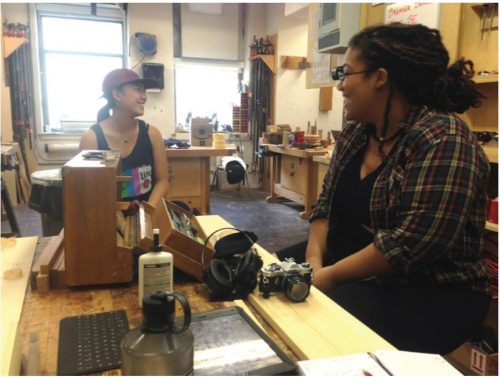
The Benchroom: Genuine, earnest and valuable conversations. Photo: Seán Breen
The physical layout of the UArts facilities was equally important to the successful cross-pollination amongst residents. The separation of the machine room and benchroom allowed for conversations to happen naturally in a calmer, quieter environment. These marvelous conversations at workbenches, which are side by side, often started upon seeing a fellow resident trying a new technique, actively seeking support, and frequently when the time came to eat. They were unlabored and provided much stimulus and, I would argue, are as valuable to the wholeness of the residents as the magnificent objects they have gone on to produce. Tara Inman-Bellofatto, the wood shop technician, is attentive to the needs of the residents and this helps to smooth the day’s ebb and flow.
The act of documenting the residency made its own impact on cross-pollination. Cristina Tamarez, the Photojournalist in Residence, served as a marker at different stages, providing the artists with an opportunity to reflect on what is all too often missed. Her photography would highlight an important moment to the group by the action of gathering the characters present for a shot. She also drew attention to the seemingly mundane, moments undoubtably full of intrigue, by subtly taking photos unbeknownst to those present. These special moments then became open to further discussion. Being a novice in the field of woodworking residents would readily share their knowledge with her. Indeed my own role to encourage scholarly debate worked in tandem with Cristina’s. With the fleeting nature of residencies, documentation is essential in the retention of methodologies and building up a repository of data.
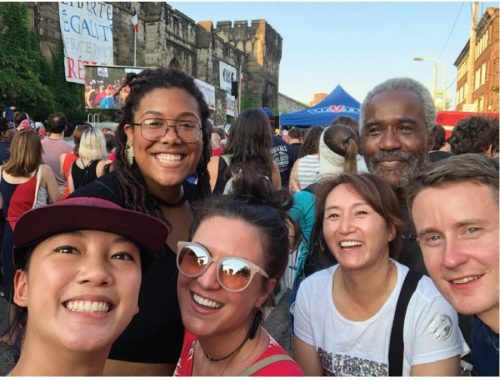
The last Philly Storming of the Bastille. Photo: Vivian Chiu
The social setting created by the close proximity of the workshop and dormitories allowed those residents who preferred to maintain a concentrated focus throughout the working day an opportunity to enjoy one another’s company and discuss progress in the relaxed setting of meals cooked in the dorms, over a cold beer, or at a quickly assembled dinner out with one another. The collocation of a curated group of individuals can have wonderful effects. Through discussions with artist Susan Hagen, as she welcomed us into her home, it appears there is true rigour to this process and the results are self-evident.
The visits to collectors, contemporary innovators like Mark Sfirri, and storied makers such as George Nakashima’s workshop, stimulated the opportunity for open exchange and conversations. Though a diversion from the workshop, these experiences provided a touchpoint for residents to gather, break down social barriers, and exchange thoughts on the wider ether of creative practice.
Interviews with each artist deepened by understanding of how residency cross-pollination occurred. This essay does not form their express opinions but rather my interpretations of our discussions. Michael Puryear has been influenced by elements of physical structures in his work and came with a very open approach. Indeed, this opened mindedness led to many wide ranging and satisfying conversations between us. Michael felt that the interactions and social aspect was primarily the value of residencies. Being aware of others ongoing work can prove interesting and though it may not immediately manifest itself in one’s own work, in the future it may. He is a proponent of the ‘Soft Eye’, which certainly merits further exploration by the reader of his writing and with Michael himself.
Janine Wang appreciated the opportunity to work on something entirely for herself unfettered by an academic structure. The casual curious conversations have added to her experience, and naturally the quiet of the benchroom has best facilitated this residency cross-pollination. Social settings provide welcome interactions. If those conversations were as relishing as the dishes Janine and resident photographer Cristina Tamarez often cooked together they are priceless.
Cha Jong-Rye’s stimulus lies in nature and her own ongoing process where inspiration is self-perpetuating. The residency has allowed her to explore turning with guidance from those in the workshop. She has come with a truly open mind and cross-pollination, excitement, and enjoyment has flowed from this starting point.
Jack Mauch has a varied basis of stimulation in his process, much like my own in fact, including but certainly not limited to decorative arts, tessalations, tilework, and product design. The opportunity to see other makers’ processes in close proximity is a natural valuable occurrence on residencies. Indeed, a prior instance of residency cross-pollination led to his exploration of sand shading. Residencies serve to galvanize approaches and provide drive in one’s work.
Vivian Chiu has benefited from fellow residents’ life lessons and conceptual knowledge. Equally she is prepared to reciprocate in this cross-pollination of personal experience and technical advancement. This is a vitally important trait found amongst residents. Mealtimes have proved to offer the greatest opportunity to share information, the all-important conversation. A wonderful succinct quote which helped clear my own view of the types of residency cross-pollination occurred during our interview: ‘there is some need-based socialising and some want-based socialising’.
The support of the Center has enabled Morgan Hill to fully explore her practice with the provision of tools and space. The social aspect of the residency, the opportunity to discuss the ongoing work, is an important waylay in her process. The Studio Open Day provided a structured opportunity to gain insight into the voice of her work in the public perception.
The experiences of the residency have left me with indelible cherished memories. Greater than my own impressions, the foundation and administrative acumen created by Albert LeCoff and the ongoing work of Navva Milliken and the staff will cross the Atlantic and embed itself in an Irish setting. As I have said, from a resident’s perspective the latent curation of residency crosspollination appears effortless and herein lies one of the most valuable facets of the experience. I would imagine it is anything but effortless. It is undoubtedly due to the rigorous approach of the staff, board members, and volunteers of the Center that such valuable exchanges have taken place. To think of the magnitude and depth of influence that the residency has had on so many artists over the past 23 years is a fitting tribute to all involved.
Seán Breen
Windgate ITE Scholar in Residence, 2018
Seán Breen is a Lecturer at GMIT Letterfrack The National Centre for Excellence in Furniture Design and Technology. Having taught on woodworking programmes in England and Australia he is also a practicing Designer-Maker. He is Co-founder and Director of Ireland’s first Shared Access Workshop, Benchspace Cork. Current research interests include Coworking Crosspollination and The Mechanics of Handplane Shavings.
